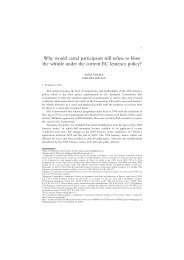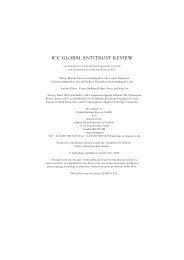GAR 2008 journal [PDF 1354 kb] - The Interdisciplinary Centre for ...
GAR 2008 journal [PDF 1354 kb] - The Interdisciplinary Centre for ...
GAR 2008 journal [PDF 1354 kb] - The Interdisciplinary Centre for ...
Create successful ePaper yourself
Turn your PDF publications into a flip-book with our unique Google optimized e-Paper software.
22<br />
GLOBAL ANTITRUST REVIEW<br />
has been hotly debated earlier by the legislator and the courts, 47 the ECJ was confronted <strong>for</strong><br />
the first time with the question at the EC level in the Albany case in the late 1990s.<br />
<strong>The</strong> Court exempted certain collective bargaining agreements ipso facto from the scope<br />
of the competition rules. 48 It grounded its decision in the balancing of two Treaty goals of<br />
implicitly equal rank, the inherent character of the restriction in the collective agreements,<br />
and the interpretation of the Treaty as a whole. It concluded that<br />
[i]t is beyond question that certain restrictions of competition are inherent in collective agreements between<br />
organisations representing employers and workers. However, the social policy objectives pursued by such<br />
agreements would be seriously undermined if management and labour were subject to Article 8[1](1) of<br />
the Treaty when seeking jointly to adopt measures to improve conditions of work and employment. …It<br />
there<strong>for</strong>e follows from an interpretation of the provisions of the Treaty as a whole which is both effective<br />
and consistent that agreements concluded in the context of collective negotiations between management<br />
and labour in pursuit of such objectives must, by virtue of their nature and purpose, be regarded as falling<br />
outside the scope of Article 8[1](1) of the Treaty. 49<br />
<strong>The</strong> Court confirmed the Albany exception in Van der Woude regading a sectoral health<br />
insurance scheme resulting from the conclusion of a collective agreement (which improved<br />
working conditions because it provided means and reduced costs) and rejected the ipso facto<br />
exception in Pavlov with respect to the unilateral establishment by a liberal profession of a<br />
pension scheme not based on a collective agreement. 50 On the basis of the homogeneity<br />
rules in the EEA-Agreement (Articles 6 and 3(2) EEA) and the respective statements<br />
including social policy objectives under the EEA-Agreement, the EFTA Court—in a<br />
slightly different factual situation—adopted the same test, clearly stressing that this only<br />
applies to collective agreements <strong>for</strong> the improvement of work and employment. 51<br />
IV. ARTICLE 81 (1) EC AND THE ‘EUROPEAN RULE OF REASON’<br />
Contrary to the structure of Section 1 of the Sherman Act, Article 81(3) EC expressly<br />
provides <strong>for</strong> an exemption of certain anti-competitive practices.<strong>The</strong> separation of the scope<br />
of Article 81(1) and (3) EC has long been a source of controversy among scholars as well as<br />
between the Commission and the Community Courts, and the distinction was crucial<br />
under the earlier en<strong>for</strong>cement regime. Despite the textual and structural differences<br />
between the EU and the US provision, the idea of a ‘rule of reason’ has repeatedly been<br />
brought into play in EC competition law, be it by scholars or by the parties to the<br />
proceedings. 52<br />
47<br />
Viol, Die Anwendbarkeit des Europäischen Kartellrechts auf Tarifverträge - unter rechtsvergleichender Betrachtung der<br />
Rechtsordnungen der Schweiz, der USA und Deutschlands, 2004, Universität St. Gallen, Hochschule für Wirtschafts-,<br />
Rechts-, und Sozialwissenschaften, Doctoral <strong>The</strong>sis; Camesasca and Van den Bergh, 'Irreconcilable principles <strong>The</strong><br />
Court of Justice exempts collective Labour Agreements from the Wrath of Antitrust', (2000) 25 European Law<br />
Review, 5, 492-508, 492, 494; AG Jacobs, C-67/96, 1999 ECR I-5751 Albany, paragraphs 96f.<br />
48<br />
ECJ, C-67/96, 1999 ECR I-5751 Albany International BV and Stichting Bedrijfspensioenfonds Textielindustrie.<br />
49<br />
Ibid., paragraph 60. Confirmed in ECJ, C-222/98, 2000 ECR I-7111 Hendrik van der Woude v Stichting Beatrixoord,<br />
paragraphs 23-27.<br />
50<br />
ECJ, C-222/98, 2000 ECR I-7111 Hendrik van der Woude v Stichting Beatrixoord, paragraph 22; EFTA Ct., E-8/00,<br />
2002 EFTA Ct. Rep. 114 Landsorganisasjonen i Norge (Norwegian Federation of Trade Unions) with Norsk Kommune<strong>for</strong>bund,<br />
paragraph 53.<br />
51<br />
EFTA Ct., E-8/00, 2002 EFTA Ct. Rep. 114 Landsorganisasjonen i Norge (Norwegian Federation of Trade Unions) with<br />
Norsk Kommune<strong>for</strong>bund, paragraph 44. Stressing, however, the limited character of the exception, paragraph 35.<br />
52<br />
See e.g. Forrester/Norall, ‘<strong>The</strong> Laizisation of Community Law: Self-help and the Rule of Reason: How<br />
Competition Law is and could be applied’. (1984) 21 CMLR, 11. Joliet, <strong>The</strong> Rule of Reason in Antitrust Law, American,<br />
German and Common Market Law in Comparative Perspective, 1967; Siragusa, in: Ehlermann/Laudati, (eds.), European<br />
Competition Law Annual, 1997 - <strong>The</strong> Objectives of Competition Policy, Ox<strong>for</strong>d, 1998, 543, 547; Whish, ibid.,. 495,<br />
499.


![GAR 2008 journal [PDF 1354 kb] - The Interdisciplinary Centre for ...](https://img.yumpu.com/36860029/32/500x640/gar-2008-journal-pdf-1354-kb-the-interdisciplinary-centre-for-.jpg)

![GAR 2009 journal [PDF 592kb] - The Interdisciplinary Centre for ...](https://img.yumpu.com/43872044/1/184x260/gar-2009-journal-pdf-592kb-the-interdisciplinary-centre-for-.jpg?quality=85)
![Law, markets and globalization (David J Gerber) [PDF 371kb] - The ...](https://img.yumpu.com/35387890/1/184x260/law-markets-and-globalization-david-j-gerber-pdf-371kb-the-.jpg?quality=85)

